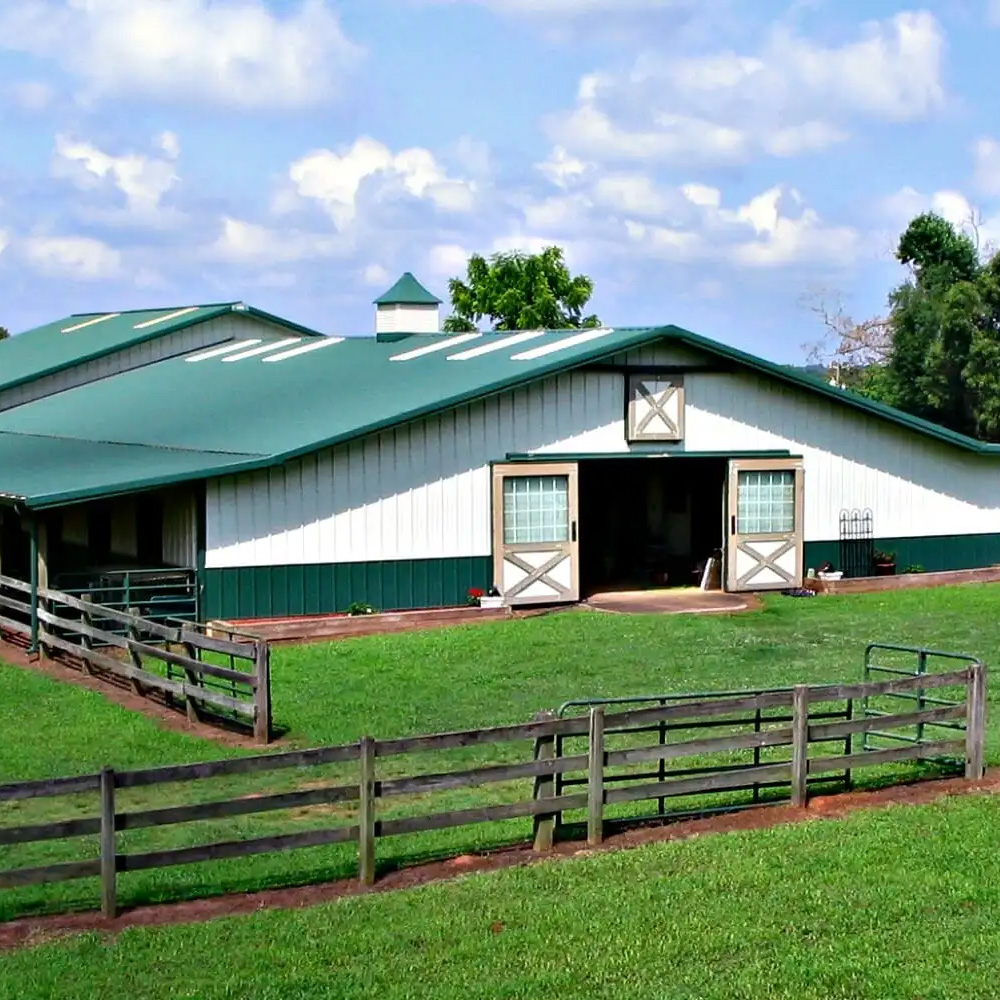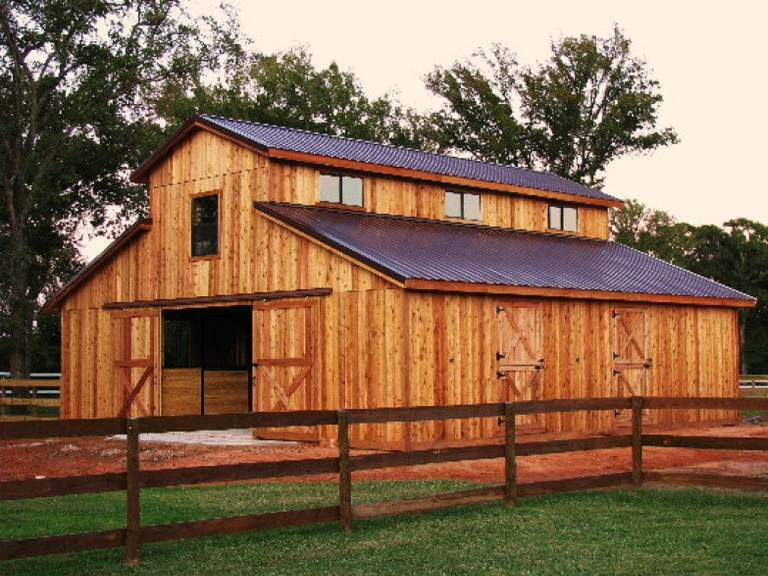Building a horse barn is a significant investment that requires careful planning and attention to detail. A well-designed horse barn not only provides safe, comfortable shelter for your horses but also creates an efficient workspace for daily care and maintenance activities.
Essential Planning Considerations
Location and Site Preparation
The location of your horse barn is crucial for both functionality and horse health. Choose a site that offers:
- Good drainage - Avoid low-lying areas prone to flooding
- Natural windbreak - Trees or hills that provide protection from prevailing winds
- Easy access - Clear paths for vehicles, trailers, and emergency services
- Proximity to utilities - Water, electricity, and waste management systems
- Future expansion - Room to grow your facility as needs change
Size and Layout Planning
The size of your horse barn depends on the number of horses you plan to house and your intended use. Consider these standard dimensions:
| Component | Minimum Size | Recommended Size |
|---|---|---|
| Box Stall | 10' x 10' | 12' x 12' or larger |
| Aisle Width | 10' | 12' - 14' |
| Ceiling Height | 8' | 10' - 12' |
| Feed Room | 8' x 10' | 10' x 12' |
| Tack Room | 8' x 10' | 12' x 14' |
Professional Tip: The Shah Construction LLC offers expertly designed horse barn kits that incorporate all these essential design elements while providing the flexibility to customize for your specific needs.
Critical Safety Features
Fire Safety and Prevention
Fire safety is paramount in horse barn design. Implement these essential features:
- Fire-resistant materials - Use metal roofing and fire-rated lumber where possible
- Electrical safety - Install GFCI outlets and use appropriate wiring for barn environments
- Hay storage separation - Keep hay storage away from stalls and electrical systems
- Emergency exits - Multiple exit routes for both horses and humans
- Fire extinguishers - Strategically placed and regularly maintained
- Smoke detectors - Heat-activated systems designed for barn environments
Ventilation Systems
Proper ventilation is essential for horse health and barn longevity. A good ventilation system should:
- Provide 4-6 air changes per hour
- Remove moisture, ammonia, and dust
- Maintain consistent temperature
- Prevent drafts at horse level
- Include both natural and mechanical ventilation options

Proper ventilation design ensures healthy air quality for horses
Stall Design and Features
Stall Construction
Well-designed stalls are the heart of any horse barn. Key considerations include:
Wall Materials
- • Solid wood or metal lower walls (4-5 feet)
- • Bar or mesh upper sections for visibility
- • Smooth surfaces to prevent injury
- • Easy-to-clean materials
Flooring Options
- • Concrete with rubber mats (most popular)
- • Clay or sand base with drainage
- • Interlocking rubber pavers
- • Proper slope for drainage (1-2%)
Door Hardware
- • Heavy-duty hinges and latches
- • Horse-safe door handles
- • Sliding or swing-out doors
- • Emergency release mechanisms
Feeding Systems
- • Corner-mounted feed buckets
- • Automatic waterers or buckets
- • Hay nets or racks
- • Easy access for cleaning
Essential Barn Areas
Feed Storage and Preparation
A dedicated feed room is essential for maintaining feed quality and preventing contamination:
- Rodent-proof storage - Metal containers or sealed bins
- Climate control - Proper ventilation and moisture control
- Easy access - Wide doors for feed delivery
- Organization systems - Shelving and labeling for different feeds
- Separate hay storage - Away from electrical systems and stalls
Tack and Equipment Storage
A well-organized tack room protects valuable equipment and improves efficiency:
- Climate-controlled environment to prevent mold and mildew
- Saddle racks and bridle hooks
- Blanket storage areas
- Cleaning and maintenance station
- Security features for valuable equipment
Wash and Grooming Areas
Include dedicated spaces for horse care and maintenance:
- Cross-tie areas with proper drainage
- Hot and cold water access
- Non-slip flooring
- Good lighting for detailed work
- Storage for grooming supplies
Complete Horse Barn Solutions
The Shah Construction LLC offers comprehensive horse barn kits that include all these essential features. Our designs are based on decades of experience and input from equestrian professionals.
Construction Materials and Methods
Structural Framework
Choose materials that provide durability and longevity:
- Post-frame construction - Cost-effective and durable for large spans
- Engineered lumber - Consistent quality and strength
- Metal roofing - Long-lasting and fire-resistant
- Proper foundation - Concrete footings for posts and equipment
Exterior Considerations
The exterior should withstand weather while providing an attractive appearance:
- Weather-resistant siding materials
- Proper roof overhang for weather protection
- Gutters and downspouts for water management
- Large doors for equipment and trailer access
- Windows for natural light and ventilation
Technology and Modern Features
Lighting Systems
Proper lighting improves safety and functionality:
- LED fixtures for energy efficiency
- Motion sensors for automatic operation
- Emergency lighting systems
- Task lighting in work areas
- Natural light through windows and skylights
Security and Monitoring
Modern barns can include advanced security features:
- Security cameras with remote monitoring
- Alarm systems for unauthorized access
- Temperature and humidity monitoring
- Automatic stall door systems
- Communication systems for emergencies
Budgeting and Cost Considerations
Horse barn construction costs vary significantly based on size, features, and location. Here's a general breakdown:
| Barn Type | Cost Range (per sq ft) | Features Included |
|---|---|---|
| Basic Shelter | $15-$25 | Simple structure, minimal features |
| Standard Barn | $30-$50 | Stalls, basic utilities, tack room |
| Premium Facility | $60-$100+ | Full amenities, high-end finishes |
Maintenance and Longevity
A well-built horse barn requires regular maintenance to ensure longevity:
- Daily cleaning - Remove manure and maintain stall bedding
- Weekly inspections - Check for damage or wear
- Seasonal maintenance - Roof, gutters, and ventilation systems
- Annual reviews - Electrical, plumbing, and structural components
- Preventive care - Address issues before they become major problems
Conclusion
Building the perfect horse barn requires careful planning, attention to detail, and quality construction. By focusing on safety, functionality, and horse comfort, you can create a facility that serves your needs for decades to come.
The Shah Construction LLC specializes in horse barn construction and can help you design and build the perfect facility for your equestrian needs. Our experienced team understands the unique requirements of horse facilities and can guide you through every step of the process.
Ready to Build Your Horse Barn?
Contact The Shah Construction LLC today to discuss your horse barn project. We'll help you create a safe, functional, and beautiful facility that meets all your equestrian needs.
Related Articles
Custom Home Kits vs Traditional Construction
Compare the benefits of custom home kits versus traditional construction methods.
Cabin Kit Construction: Your Gateway to Mountain Living
Explore the benefits of cabin kits for your mountain retreat and construction process.

